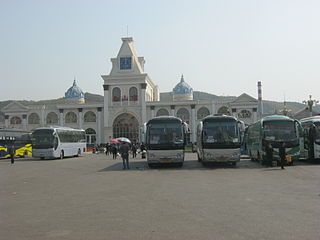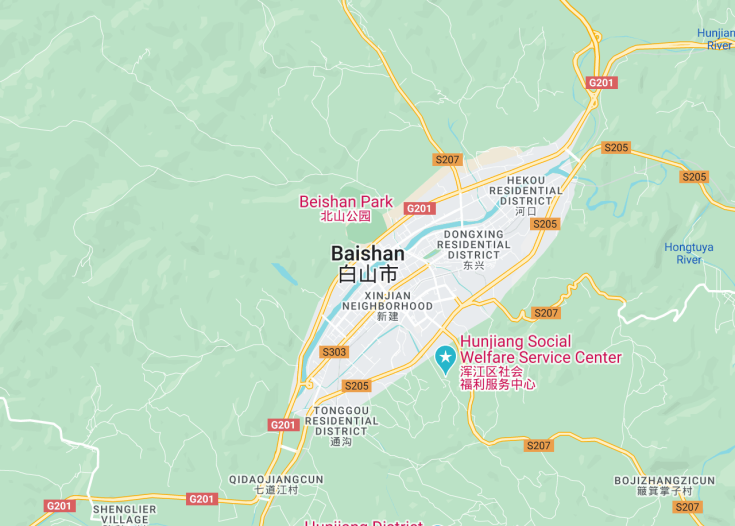Baishan, located in Jilin Province, China, encapsulates a pristine blend of natural beauty and cultural richness. This city, often overshadowed by more well-known destinations, offers a unique experience with its stunning landscapes dominated by the Changbai Mountains and the heavenly Lake Tianchi. Known as the gateway to Changbaishan Nature Reserve, Baishan serves as a perfect starting point for explorations into diverse ecosystems and offers opportunities for mountaineering, skiing, and hot spring baths. The area is also steeped in ethnic heritage, particularly of the Korean-Chinese community, adding a unique cultural layer to its breathtaking natural attractions.
For an unforgettable experience, visit Baishan during the spring or early autumn to enjoy the optimal weather and vibrant seasonal colors that accentuate its natural beauty.
Consider scheduling a guided tour through Changbaishan Nature Reserve to fully appreciate the local wildlife and learn about the ecological significance of the region’s diverse habitats.
Top things to do & see in Baishan
Select the following sights and activities to discover best tickets and tours available in Baishan.
Baishan: The Hidden Gem of Northeast China
| Country | China |
| Time in Baishan | GMT+8 |
| Language spoken | Mandarin |
| Population | 1.14 million (Source: National Bureau of Statistics of China, 2022) |
| Currency | Chinese Yuan (CNY ¥) |
| Airports |
|
Baishan, a city in Jilin Province of Northeast China, is steeped in history and enriched with cultural and natural beauty. Sitting close to the border with North Korea, Baishan is strategically significant and naturally endowed with the spectacular Changbai Mountain range. This range is not only a major geographical landmark but also home to the renowned Heaven Lake, making Baishan a prominent place for both natural beauty and folklore.
The city’s name, meaning “White Mountain,” is aptly derived from the perennially snow-capped peaks of Changbai. Historically, Baishan’s development has been closely tied with the forestry industry, although recent years have seen a pivot towards tourism and renewable energy developments, reflecting China’s broader economic shifts. The local culture is a tapestry woven with Han Chinese and Korean threads, offering unique cultural festivals and cuisines that attract visitors from across the region.
Baishan serves as an excellent gateway for eco-tourism. The flora and fauna of its mountain ranges present innumerable opportunities for scientific research and relaxing retreats. Meanwhile, the city’s infrastructure development, including the establishment of Changbaishan Airport, makes it more accessible to international tourists. The government’s ongoing efforts to promote green energy and conservation are evident in the extensive nature reserves that host rare species like the Amur tiger and the Siberian leopard.
Despite its rugged, mountainous terrain, Baishan boasts robust connectivity within China thanks to a well-developed network of roads and the local airport. This connectivity aids its burgeoning tourism sector and facilitates economic links with major urban centers in the northeast.
Where is Baishan?
Located in the southeastern part of Jilin Province in China, Baishan is nestled near the scenic Changbai Mountains close to the DPRK border.
Distances:
| Route | Distance by car | Time by car |
|---|---|---|
| Beijing to Baishan | 827 miles (1331 km) | Approx. 14 hours |
| Shenyang to Baishan | 316 miles (509 km) | Approx. 6 hours |
| Changchun to Baishan | 228 miles (367 km) | Approx. 5 hours |
What is Baishan famous for?
Baishan is famed for its pristine natural landscapes, particularly the Changbai Mountain Range and the ethereal Heaven Lake. These natural wonders attract nature enthusiasts and scholars alike.
History
Ancient Period
The history of Baishan, located in the southeastern region of Jilin Province in China, can be traced back several millennia. The area was originally inhabited by various Tungusic tribes, ancestors of the Manchu people, who were predominantly hunter-gatherers and utilized the rich forestry resources of the region. Artifacts and records suggest that these tribes had established a unique culture and social structures long before any significant Han Chinese settlements.
Qing Dynasty (1636-1912)
Baishan’s strategic significance became more pronounced during the Qing Dynasty. It was during this period that the Qing government established tighter control over the region to protect it from Russian expansionism. The area was also an important route for the movements of the Qing military as well as being a lucrative site for ginseng harvesting, which was a major economic activity at the time.
Modern Era (1912-Present)
Following the fall of the Qing Dynasty, Baishan witnessed significant changes. Throughout the Republican era and subsequent Japanese occupation, Baishan remained relatively underdeveloped. However, after the founding of the People’s Republic of China in 1949, Baishan began to develop industrially, leveraging its natural resources, particularly in forestry and mining. In recent decades, as China has focused more on sustainable development, Baishan has been transitioning towards a more tourism-oriented economy, capitalizing on its natural beauty and historic sites.
Visit Baishan
What to see and do in Baishan, China
Visitors to Baishan are treated to a mix of natural beauty and cultural heritage. Key attractions include:
- Changbai Mountain: Renowned for its Heavenly Lake and pristine alpine landscapes.
- Wangtiane Scenic Area: Offers breathtaking views and is perfect for hiking enthusiasts.
- Changbai Waterfall: One of the highest waterfalls in China, providing spectacular photo opportunities.
- Hot Springs: Relax in one of the many natural hot springs, believed to have healing properties.
- Cultural experiences: Engage with the local Manchu and Korean ethnic communities to learn about their traditional lifestyles and cuisines.
Festive Traditions in Baishan
Baishan hosts various annual events that reflect its rich cultural tapestry. The Changbai Mountain Ice and Snow Festival, held from December to February, features ice sculptures and winter sports. During the summer, the Changbai Mountain Rhododendron Festival showcases the region’s floral beauty, offering botanical tours and photographic expeditions.
Best time to visit Baishan
The ideal time to visit Baishan depends largely on visitor interests. Winter enthusiasts should plan their visit during December to February for the snow festival and skiing. For those interested in mild weather and natural scenery, late spring and early autumn are recommended, offering vibrant foliage and comfortable temperatures.
Is Baishan worth visiting?
Baishan offers a compelling blend of natural wonders and cultural richness, making it a noteworthy destination for those interested in China’s less urbanized landscapes and ethnic heritage. However, its remote location and colder climate may pose challenges for some travelers. The appeal lies in its tranquil beauty and the opportunity to experience traditional lifestyles, which can be a significant departure from China’s bustling metropolitan centers. Visitors seeking peace and natural beauty will find Baishan well worth the visit, while those preferring more urban attractions might find it less appealing.










